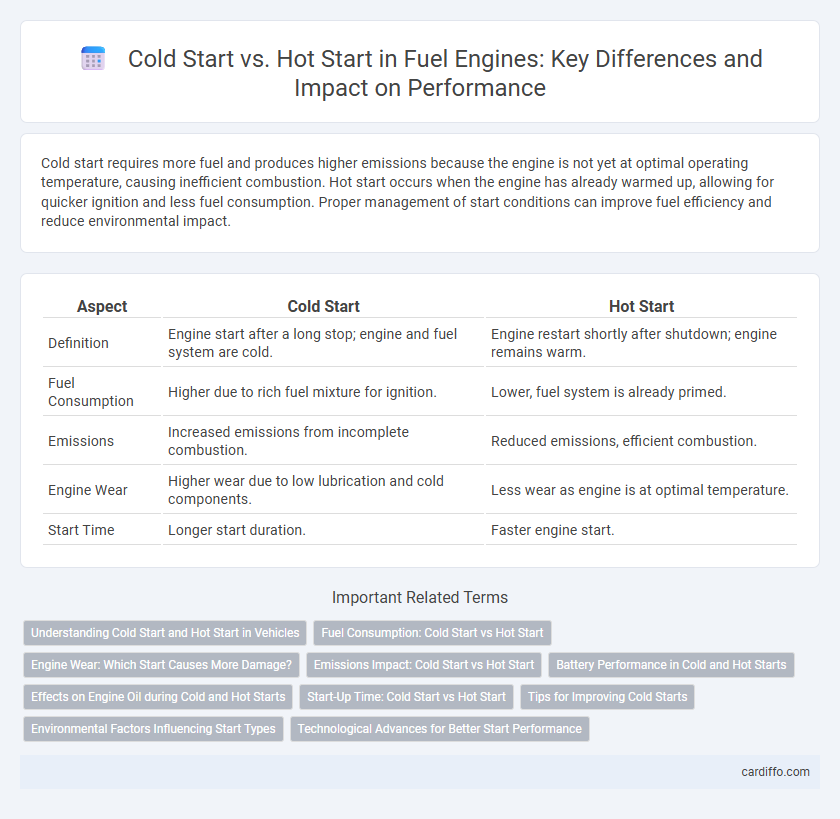Cold start requires more fuel and produces higher emissions because the engine is not yet at optimal operating temperature, causing inefficient combustion. Hot start occurs when the engine has already warmed up, allowing for quicker ignition and less fuel consumption. Proper management of start conditions can improve fuel efficiency and reduce environmental impact.
Table of Comparison
| Aspect | Cold Start | Hot Start |
|---|---|---|
| Definition | Engine start after a long stop; engine and fuel system are cold. | Engine restart shortly after shutdown; engine remains warm. |
| Fuel Consumption | Higher due to rich fuel mixture for ignition. | Lower, fuel system is already primed. |
| Emissions | Increased emissions from incomplete combustion. | Reduced emissions, efficient combustion. |
| Engine Wear | Higher wear due to low lubrication and cold components. | Less wear as engine is at optimal temperature. |
| Start Time | Longer start duration. | Faster engine start. |
Understanding Cold Start and Hot Start in Vehicles
Cold start occurs when a vehicle's engine is started after being off for an extended period, causing thicker engine oil and lower fuel vaporization that affects performance and emissions. Hot start happens shortly after the engine is turned off, with components like the catalytic converter still warm, leading to quicker ignition and reduced fuel consumption. Understanding the difference aids in optimizing fuel injection systems and minimizing engine wear during varying temperature conditions.
Fuel Consumption: Cold Start vs Hot Start
Cold start fuel consumption is significantly higher due to the engine operating below optimal temperature, causing incomplete combustion and increased fuel use. Hot start fuel consumption is lower because the engine is already warm, enabling efficient fuel vaporization and reduced fuel enrichment. Minimizing cold starts can lead to substantial fuel savings and lower emissions over time.
Engine Wear: Which Start Causes More Damage?
Cold starts cause more engine wear compared to hot starts due to the lower initial oil temperature and higher friction between engine components. During a cold start, fuel combustion is less efficient, leading to increased residue and deposits that accelerate wear on pistons, cylinders, and bearings. Hot starts benefit from circulating warm oil, which provides better lubrication and reduces metal-to-metal contact, minimizing engine damage over time.
Emissions Impact: Cold Start vs Hot Start
Cold start engine emissions are significantly higher because the fuel combustion process is less efficient when the engine and catalytic converter are cold, leading to increased release of hydrocarbons (HC), carbon monoxide (CO), and nitrogen oxides (NOx). Hot start emissions are lower due to the catalyst reaching optimal operating temperature, which drastically reduces pollutant levels by enhancing the oxidation of unburned fuel and the reduction of NOx. Studies indicate cold starts can produce up to 70% more emissions compared to hot starts, emphasizing the importance of warm-up strategies in reducing vehicular air pollution.
Battery Performance in Cold and Hot Starts
Battery performance significantly impacts cold start efficiency, as lower temperatures reduce chemical activity and capacity, causing slower engine cranking and increased fuel consumption. In contrast, hot starts benefit from higher battery temperatures that maintain optimal chemical reactions, ensuring quicker engine ignition and reduced fuel usage. Effective battery management systems optimize charge retention and delivery for both cold and hot starts, enhancing overall fuel efficiency.
Effects on Engine Oil during Cold and Hot Starts
Cold starts cause engine oil to thicken due to low temperatures, reducing lubrication efficiency and increasing wear on engine components. Hot starts allow engine oil to remain at optimal viscosity, ensuring proper lubrication and minimizing friction-related damage. Frequent cold starts accelerate oil degradation and sludge formation, compromising engine performance and longevity.
Start-Up Time: Cold Start vs Hot Start
Cold start engines require more time to reach optimal operating temperature, leading to longer start-up times due to fuel condensation and limited vaporization. Hot start engines benefit from residual heat, enabling faster fuel vaporization and significantly quicker ignition, which reduces start-up time substantially. Efficient fuel delivery systems play a crucial role in minimizing delays during both cold and hot starts.
Tips for Improving Cold Starts
Using high-quality fuel with proper additives enhances fuel combustion during cold starts, reducing engine misfires and improving ignition. Ensuring the battery is fully charged and in good condition supports the starter motor's efficiency, which is critical when the engine is cold. Regular maintenance of spark plugs and fuel injectors helps maintain optimal fuel delivery and ignition timing, facilitating smoother cold starts.
Environmental Factors Influencing Start Types
Cold start and hot start in engines are significantly influenced by environmental factors such as temperature and humidity. Low ambient temperatures increase fuel viscosity and reduce vaporization, causing difficulties in cold starts, while hot starts benefit from residual engine heat that facilitates quicker ignition. Humidity also affects air-fuel mixture combustion efficiency, impacting the ease and emissions of both start types.
Technological Advances for Better Start Performance
Technological advances in fuel injection systems and electronic control units have significantly improved cold start and hot start performance by optimizing fuel atomization and air-fuel mixture precision. Advanced sensors and software algorithms dynamically adjust ignition timing and fuel delivery based on engine temperature, reducing emissions and ensuring faster engine ignition. Innovations like direct injection and start-stop technology enhance reliability and efficiency, minimizing engine wear during both cold and hot start conditions.
Cold Start vs Hot Start Infographic

 cardiffo.com
cardiffo.com